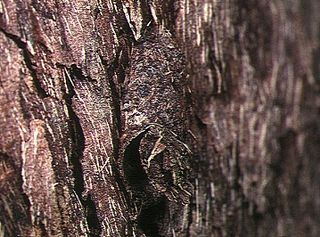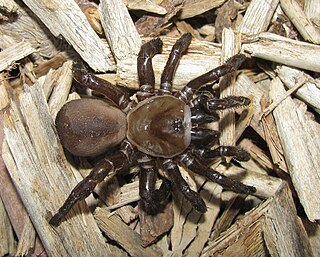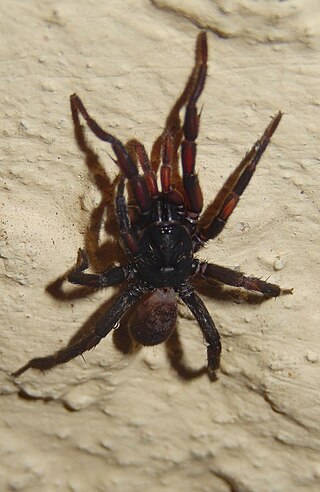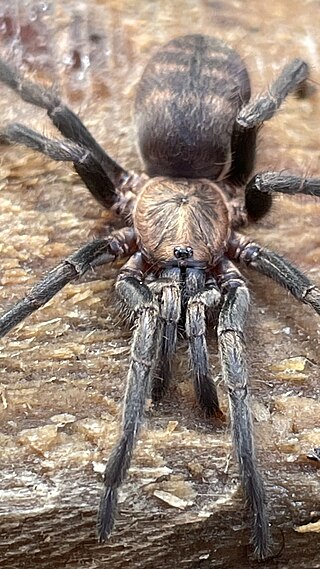
The Mygalomorphae, or mygalomorphs, are an infraorder of spiders, and comprise one of three major groups of living spiders with over 3,000 species, found on all continents except Antarctica. Many members are known as trapdoor spiders due to their creation of trapdoors over their burrows. Other prominent groups include Australian funnel web spiders and tarantulas, with the latter accounting for around one third of all mygalomorphs.

The family Cyrtaucheniidae, known as wafer-lid trapdoor spiders, are a widespread family of Mygalomorphae spiders.

Nemesiidae, also known as funnel-web trapdoor spiders, is a family of mygalomorph spiders first described by Eugène Simon in 1889, and raised to family status in 1985. Before becoming its own family, it was considered part of "Dipluridae".

Cyclocosmia is a genus of mygalomorph trapdoor spiders in the family Halonoproctidae, first described by Anton Ausserer in 1871. Originally placed with the Ctenizidae, when the family split in 2018, this genus was placed with the Halonoproctidae as the type genus. The name is derived from the Greek "kyklos" (κυκλος), meaning "circle", and "kosmeo" (κοσμεω), meaning "to adorn".

Stanwellia is a genus of South Pacific mygalomorph spiders in the family Pycnothelidae. It was first described by W. J. Rainbow & R. H. Pulleine in 1918. Originally placed with the curtain-web spiders, it was transferred to the funnel-web trapdoor spiders in 1985, then to the Pycnothelidae in 2020. It is a senior synonym of Aparua.
Baltocteniza is an extinct monotypic genus of spider in the family Ctenizidae. At present, it contains the single species Baltocteniza kulickae. The genus is solely known from the Early Eocene Baltic amber deposits in the Baltic Sea region of Europe.
Electrocteniza is an extinct monotypic genus of spider in the family Ctenizidae. At present, it contains the single species Electrocteniza sadilenkoi. The genus is solely known from the Early Eocene Baltic amber deposits in the Baltic Sea region of Europe.

The Euctenizidae are a family of mygalomorph spiders. They are now considered to be more closely related to Idiopidae.

Latouchia is a genus of Asian mygalomorph spiders in the family Halonoproctidae, first described by Reginald Innes Pocock in 1901. Originally placed with the Ctenizidae, it was moved to the Halonoproctidae in 2018.

Conothele is a genus of mygalomorph spiders in the family Halonoproctidae, first described by Tamerlan Thorell in 1878. Originally placed with the Ctenizidae, it was moved to the Halonoproctidae in 2018.
Entypesa is a genus of African mygalomorph spiders in the family Entypesidae. It was first described by Eugène Louis Simon in 1902. Originally placed with the curtain-web spiders, it was transferred to the funnel-web trapdoor spiders in 1985, then to the Entypesidae in 2020. It is a senior synonym of Pseudohermacha.
Pionothele is a genus of African mygalomorph spiders in the family Pycnothelidae. It was first described by William Frederick Purcell in 1902. As of June 2020 it contains 2 species, found in Namibia and South Africa: P. gobabeb, and P. straminea. Originally placed with the Ctenizidae, it was transferred to the funnel-web trapdoor spiders in 1985, then to the Pycnothelidae in 2020.

Halonoproctidae is a family of mygalomorph spiders, split off from the family Ctenizidae in 2018. Species in the family are widely distributed in North and Central America, Australasia, Asia, southern Europe and North Africa. One species is recorded from Venezuela in South America. They are relatively large, sombrely coloured spiders, that live in burrows with some kind of trapdoor.

Avicularioidea is a clade of mygalomorph spiders, one of the two main clades into which mygalomorphs are divided. It has been treated at the rank of superfamily.

Anamidae is a family of Australian mygalomorph spiders. It was first described as a tribe by Simon in 1889, then raised to the subfamily Anaminae of the family Nemesiidae, before being raised to a family level by Opatova et al. in 2020.
Bemmeridae is a family of African and Asian mygalomorph spiders that was first described as the tribe Bemmereae by Eugène Simon in 1903. It was elevated to a subfamily of funnel-web trapdoor spiders (Bemmerinae) in 1985, then to its own family in 2020.

Pycnothelidae is a family of mygalomorph spiders first described in 1917. It was downgraded to a subfamily of the funnel-web trapdoor spiders in 1985, but returned to family status in 2020.

Bipectina is a clade of avicularioid mygalomorph spiders first proposed by Pablo A. Goloboff in 1993, based on a morphological cladistic analysis. The clade was marked by a number of morphological features, and in particular by the presence of two rows of teeth on the superior tarsal claws of the legs of both sexes, meaning that the claws were bipectinate. The clade was supported by some subsequent analyses, although not all. A major phylogenetic study in 2020 upheld the monophyly of the clade, which contained 19 of the 25 accepted families of the Avicularioidea.

Domiothelina is a clade of avicularioid mygalomorph spiders first proposed by Robert J. Raven in 1985, based on a morphological cladistic analysis. Raven characterized the clade by a number of shared features, including the domed apical segment of the posterior lateral spinnerets. The clade has been supported to some degree by subsequent molecular analyses, although with a somewhat different composition.

Nemesioidina is a clade of avicularioid mygalomorph spiders proposed in 2020, based on a molecular phylogenetic analysis.














